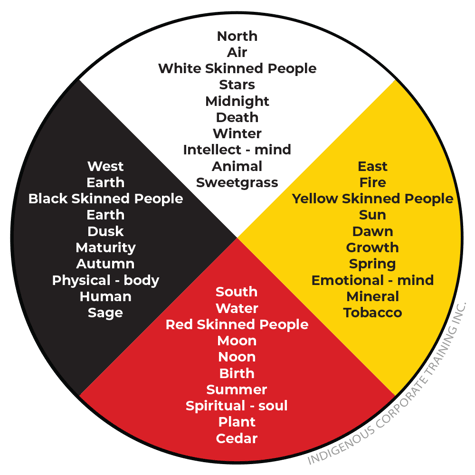Indigenous Medicine Wheel
Healthcare is not delivered in a culturally-neutral environment. It comes with a philosophy, value system, context, and culture. Although Get Well Clinic is rooted in the Western scientific tradition of healthcare, and founded with a set of values and beliefs; we recognize that there is an approach to healing that preceded all of us. We can learn from the wisdom of the Indigenous peoples, from the Creator or the Great Spirit, who inspire us to be in right relationship with each other and with the land.
The First Nations, Métis, and Inuit are diverse groups of Indigenous Peoples that have various languages, cultures, spirituality, and practices, so there is not one uniform explanation of traditional healing and medicine. However, many First Nations share a similar concept called the Medicine Wheel which symbolize the relationship between four related elements that are at play in life and healing.
Learn more about the traditional Indigenous Medicine Wheel with Bob Joseph.
Learn more about an Indigenous framework for First Nations Mental Wellness Continuum by the Thunderbird Partnership Foundation. Learn from Indigenous elder, Dr. Carol Hopkins, on how this Framework is used by the Thunderbird Partnership Foundation.
[Image Credit: Bob Joseph, Indigenous Corporate Training Inc.]

(Reference: Medicine Wheel illustration from Indigenous Corporate Training Inc.)
[Excepts from Ontario.ca]
The Medicine Wheel represents a First Nations way of life, beliefs and teachings that have existed for thousands of years. It is a circle divided into four coloured sections, red, yellow, white and a dark colour such as blue or black. It can be set out using stones or drawn.
Interpreting the Wheel
First Nations communities across Ontario and North America interpret the Medicine Wheel in slightly unique ways. The wheel is often used as a tool for healing and for teaching life skills. Some of the most common interpretations of the colours, include the seasons and directions:
Yellow represents the East or Spring
Red represents the South or Summer
Dark blue or black represents the West or Autumn
White represents the North or Winter
Other interpretations can also include the elements - earth, water, sky and fire.
Interpretations in Ontario First Nations Cultures
Three First Nations cultural groups that have long histories in Ontario include the Anishinabek, the Omushkego and the Haudenosaunee.
The Anishinabek refer to the Medicine Wheel as the circle of life, symbolizing the natural cycles of birth, growth, death, and regeneration. The wheel represents all life including animals, plants, minerals and humans. It is also signifies the cycles of nature - the seasons, the moon, days and nights.
To the Omushkego, the Medicine Wheel is also a metaphor for the knowledge of the elders.
The Medicine Wheel is a place of prayer and learning. It is a symbol of healing and interconnectedness and often represents our place in nature and how we are related to our environment.
(Reference: The Medicine Wheel, A Way of Life, Indigenous Affairs, 17-June-2010)